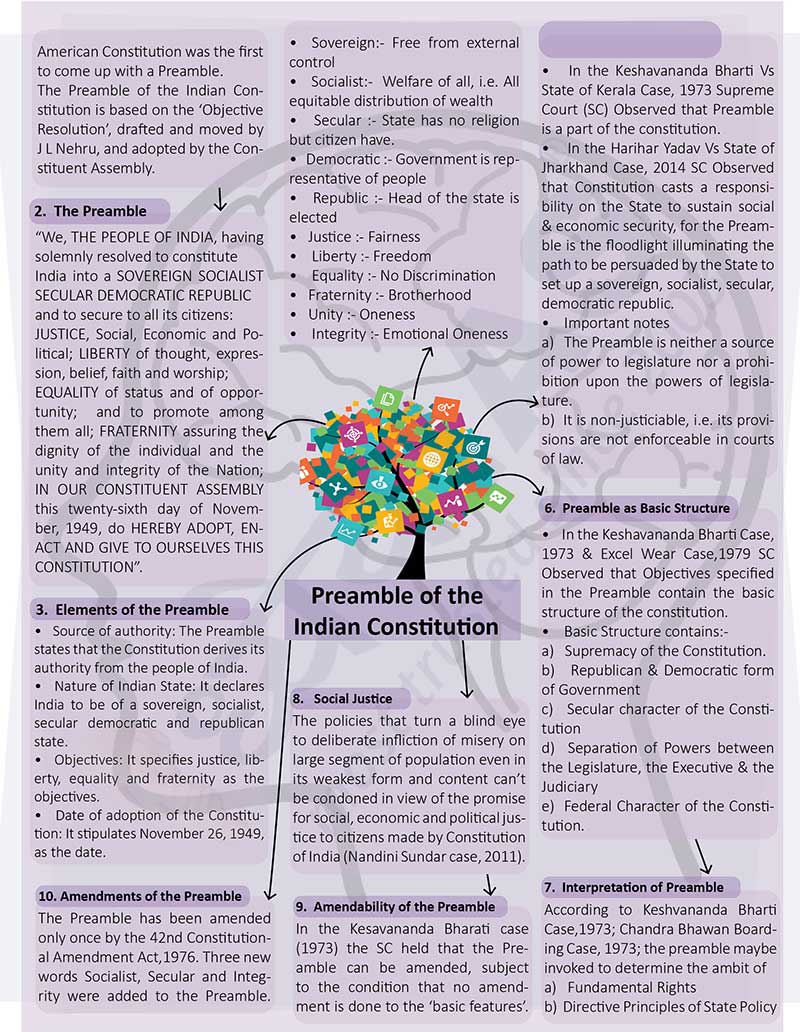Background
- American Constitution was the first to come up with a Preamble. The Preamble of the Indian Constitution is based on the ‘Objective Resolution’, drafted and moved by J L Nehru, and adopted by the Constituent Assembly.
The Preamble
- “We, THE PEOPLE OF INDIA, having solemnly resolved to constitute India into a SOVEREIGN SOCIALIST SECULAR DEMOCRATIC REPUBLIC and to secure to all its citizens: JUSTICE, Social, Economic and Political; LIBERTY of thought, expression, belief, faith and worship; EQUALITY of status and of opportunity; and to promote among them all; FRATERNITY assuring the dignity of the individual and the unity and integrity of the Nation; IN OUR CONSTITUENT ASSEMBLY this twenty-sixth day of November, 1949, do HEREBY ADOPT, ENACT AND GIVE TO OURSELVES THIS CONSTITUTION”.
Elements of the Preamble
- Source of authority: The Preamble states that the Constitution derives its authority from the people of India.
- Nature of Indian State: It declares India to be of a sovereign, socialist, secular democratic and republican state.
- Objectives: It specifies justice, liberty, equality and fraternity as the objectives.
- Date of adoption of the Constitution: It stipulates November 26, 1949, as the date.
Building blocks of the Preamble
- Sovereign:- Free from external control
- Socialist:- Welfare of all, i.e. All equitable distribution of wealth
- Secular :- State has no religion but citizen have.
- Democratic :- Government is representative of people
- Republic :- Head of the state is elected
- Justice :- Fairness
- Liberty :- Freedom
- Equality :- No Discrimination
- Fraternity :- Brotherhood
- Unity :- Oneness
- Integrity :- Emotional Oneness
Preamble as a part of the Constitution
- In the Keshavananda Bharti Vs State of Kerala Case, 1973 Supreme Court (SC) Observed that Preamble is a part of the constitution.
- In the Harihar Yadav Vs State of Jharkhand Case, 2014 SC Observed that Constitution casts a responsibility on the State to sustain social & economic security, for the Preamble is the floodlight illuminating the path to be persuaded by the State to set up a sovereign, socialist, secular, democratic republic.
- Important notes
- The Preamble is neither a source of power to legislature nor a prohibition upon the powers of legislature.
- It is non-justiciable, i.e. its provisions are not enforceable in courts of law.
Preamble as Basic Structure
- In the Keshavananda Bharti Case, 1973 & Excel Wear Case,1979 SC Observed that Objectives specified in the Preamble contain the basic structure of the constitution.
- Basic Structure contains:-
- Supremacy of the Constitution.
- Republican & Democratic form of Government
- Secular character of the Constitution
- Separation of Powers between the Legislature, the Executive & the Judiciary
- Federal Character of the Constitution.
Interpretation of Preamble
According to Keshvananda Bharti Case,1973; Chandra Bhawan Boarding Case, 1973; the preamble maybe invoked to determine the ambit of
- Fundamental Rights
- Directive Principles of State Policy
Social Justice
- The policies that turn a blind eye to deliberate infliction of misery on large segment of population even in its weakest form and content can’t be condoned in view of the promise for social, economic and political justice to citizens made by Constitution of India (Nandini Sundar case, 2011).
Amenability of the Preamble
- In the Kesavananda Bharati case (1973) the SC held that the Preamble can be amended, subject to the condition that no amendment is done to the ‘basic features’.
Amendments of the Preamble
- The Preamble has been amended only once by the 42nd Constitutional Amendment Act,1976. Three new words Socialist, Secular and Integrity were added to the Preamble.







